Experimental Study on a Multi-Evaporator Refrigeration System Equipped with EEV-Based Ejector
Abstract
:1. Introduction
- The refrigerant enters the compressor at low pressure at state (1), and is compressed to the high-pressure point at state (2).
- The high-pressure refrigerant enters the condenser and is condensed to states (3) and (4), and then flows through expansion valves at states (5) and (6).
- Then, two-phase refrigerants enter two evaporators, and the refrigerants become superheated at states (7) and (8).
- Superheated refrigerants enter the EEV-based ejector and mix with each other.
- The mixed flow leaves the EEV-based ejector with a pressure lift and obtains the state (1), and the cycle is completed.
- First, a hybrid PRV- and ejector-based vapor-compression refrigeration system was established, in which PRV-based vapor-compression mode and ejector-based vapor-compression mode could be operated.
- Second, the performances of PRV- and ejector-based modes were identified through the experiments.
- Third, both the ejector and system performances were identified by varying the ejector spindle-blocking area percentage.
- Last, the system performance was verified by varying the condensing temperature.
2. Experimental Setup
- PT1000 platinum resistance temperature sensors with error of ±0.3 °C;
- pressure transducers with full scale error of 0.5%;
- two oval wheal flow meters with error of ±0.5%.
3. Geometrical Details of the EEV-Based Ejector
4. Results and Discussion
4.1. System Performance of Both Modes
4.2. Effect of Spindle-Blocking Percentage on the Ejector Entrainment Ratio and System Performance
4.3. Effect of Condensing Temperature on System Performance
5. Conclusions
- (1)
- With the increase in the cooling capacity, the COP of both modes increased. The ejector-based mode had a COP 3.6% higher than the PRV-based vapor-compression mode.
- (2)
- With the increase in the ejector spindle-blocking percentage, ER dropped by 52% and COP dropped by 30.8%. The effect of the blocking percentage on ER seemed more evident than that on COP.
- (3)
- The system COP decreased along with both the spindle-blocking area percentage and condensing temperature. In comparison, the system COP was more sensitive to the condensing temperature than the ejector spindle-blocking area percentage. Lower condensing temperature and spindle-blocking area percentage of the ejector offered better system performance.
Author Contributions
Funding
Conflicts of Interest
References
- Liu, Z.; Liu, Z.; Xin, X.; Yang, X. Proposal and assessment of a novel carbon dioxide energy storage system with electrical thermal storage and ejector condensing cycle: Energy and exergy analysis. Appl. Energy 2020, 269, 115067. [Google Scholar] [CrossRef]
- Elbel, S.; Lawrence, N. Review of recent developments in advanced ejector technology. Int. J. Refrig. 2016, 62, 1–18. [Google Scholar] [CrossRef]
- NBSC (National Bureau of Statistics of the People’s Republic of China). China Statistical Yearbook; China Statistic Press: Beijing, China, 2019. [Google Scholar]
- Rao, N.; Ummel, K. White goods for white people? Drivers of electric appliance growth in emerging economies. Energy Res. Soc. Sci. 2017, 27, 106–116. [Google Scholar] [CrossRef]
- Besagni, G.; Mereu, R.; Inzoli, F. Ejector refrigeration: A comprehensive review. Renew. Sustain. Energy Rev. 2016, 53, 373–407. [Google Scholar] [CrossRef]
- Zhu, Y.; Jiang, P. Experimental and numerical investigation of the effect of shock wave characteristics on the ejector performance. Int. J. Refrig. 2014, 40, 31–42. [Google Scholar] [CrossRef]
- Cao, H.S.; ter Brake, H.J.M. Progress and challenges in utilization of ejectors for cryogenic cooling. Appl. Therm. Eng. 2019, 167, 114783. [Google Scholar] [CrossRef]
- Atmaca, A.U.; Erek, A.; Ekren, O. Impact of the mixing theories on the performance of ejector expansion refrigeration cycles for environmentally-friendly refrigerants. Int. J. Refrig. 2018, 97, 211–225. [Google Scholar] [CrossRef]
- Sokolov, M.; Hershgal, D. Enhanced ejector refrigeration cycles powered by low grade heat. Part 1. Systems characterization. Int. J. Refrig. 1990, 13, 351–356. [Google Scholar] [CrossRef]
- Croquer, S.; Poncet, S.; Aidoun, Z. Thermodynamic Modelling of Supersonic Gas Ejector with Droplets. Entropy 2017, 19, 579. [Google Scholar] [CrossRef]
- Zhao, H.; Zhang, K.; Wang, L.; Han, J. Thermodynamic investigation of a booster-assisted ejector refrigeration system. Appl. Therm. Eng. 2016, 104, 274–281. [Google Scholar] [CrossRef]
- Hao, X.; Wang, L.; Wang, Z.; Tan, Y.; Yan, X. Hybrid auto-cascade refrigeration system coupled with a heat-driven ejector cooling cycle. Energy 2018, 161, 988–998. [Google Scholar] [CrossRef]
- Tan, Y.; Wang, L.; Liang, K. Thermodynamic performance of an auto-cascade ejector refrigeration cycle with mixed refrigerant R32 + R236fa. Appl. Therm. Eng. 2015, 84, 268–275. [Google Scholar] [CrossRef]
- Liu, Y.; Xin, T.; Cao, L.; Wan, C.; Zhang, M. Compression-injection hybrid refrigeration cycles in household refrigerators. Appl. Therm. Eng. 2010, 30, 2442–2447. [Google Scholar] [CrossRef]
- Elakdhar, M.; Nehdi, E.; Kairouani, L. Analysis of a Compression/Ejection Cycle for Domestic Refrigeration. Ind. Eng. Chem. Res. 2007, 46, 4639–4644. [Google Scholar] [CrossRef]
- Wang, X.; Yu, J. An experimental investigation on a novel ejector enhanced refrigeration cycle applied in the domestic refrigerator-freezer. Energy 2015, 93, 202–209. [Google Scholar] [CrossRef]
- Zhou, M.; Wang, X.; Yu, J. Theoretical study on a novel dual-nozzle ejector enhanced refrigeration cycle for household refrigerator-freezers. Energy Convers. Manag. 2013, 73, 278–284. [Google Scholar] [CrossRef]
- Sun, D.-W. Variable geometry ejectors and their applications in ejector refrigeration systems. Energy 1996, 21, 919–929. [Google Scholar] [CrossRef]
- Yan, J.; Cai, W.; Li, Y. Geometry parameters effect for air-cooled ejector cooling systems with R134a refrigerant. Renew. Energy 2012, 46, 155–163. [Google Scholar] [CrossRef]
- Yan, J.; Lin, C.; Cai, W.; Chen, H.; Wang, H. Experimental study on key geometric parameters of an R134A ejector cooling system. Int. J. Refrig. 2016, 67, 102–108. [Google Scholar] [CrossRef]
- Lin, C.; Cai, W.; Li, Y.; Yan, J.; Hu, Y.; Giridharan, K. Numerical investigation of geometry parameters for pressure recovery of an adjustable ejector in multi-evaporator refrigeration system. Appl. Therm. Eng. 2013, 61, 649–656. [Google Scholar] [CrossRef]
- Li, C.; Li, Y.; Cai, W.; Hu, Y.; Chen, H.; Yan, J. Analysis on performance characteristics of ejector with variable area-ratio for multi-evaporator refrigeration system based on experimental data. Appl. Therm. Eng. 2014, 68, 125–132. [Google Scholar] [CrossRef]
- Hou, W.; Wang, L.; Yan, J.; Li, X.; Wang, L. Simulation on the performance of ejector in a parallel hybrid ejector-based refrigerator-freezer cooling cycle. Energy Convers. Manag. 2017, 143, 440–447. [Google Scholar] [CrossRef]
- Thongtip, T.; Aphornratana, S. An experimental analysis of the impact of primary nozzle geometries on the ejector performance used in R141b ejector refrigerator. Appl. Therm. Eng. 2017, 110, 89–101. [Google Scholar] [CrossRef]
- Jeon, Y.; Kim, S.; Kim, D.; Chung, H.J.; Kim, Y. Performance characteristics of an R600a household refrigeration cycle with a modified two-phase ejector for various ejector geometries and operating conditions. Appl. Energy 2017, 205, 1059–1067. [Google Scholar] [CrossRef]
- Zhang, H.; Wang, L.; Yan, J.; Li, X.; Wang, L. Performance investigation of a novel EEV-based ejector for refrigerator-freezers. Appl. Therm. Eng. 2017, 121, 336–343. [Google Scholar] [CrossRef]
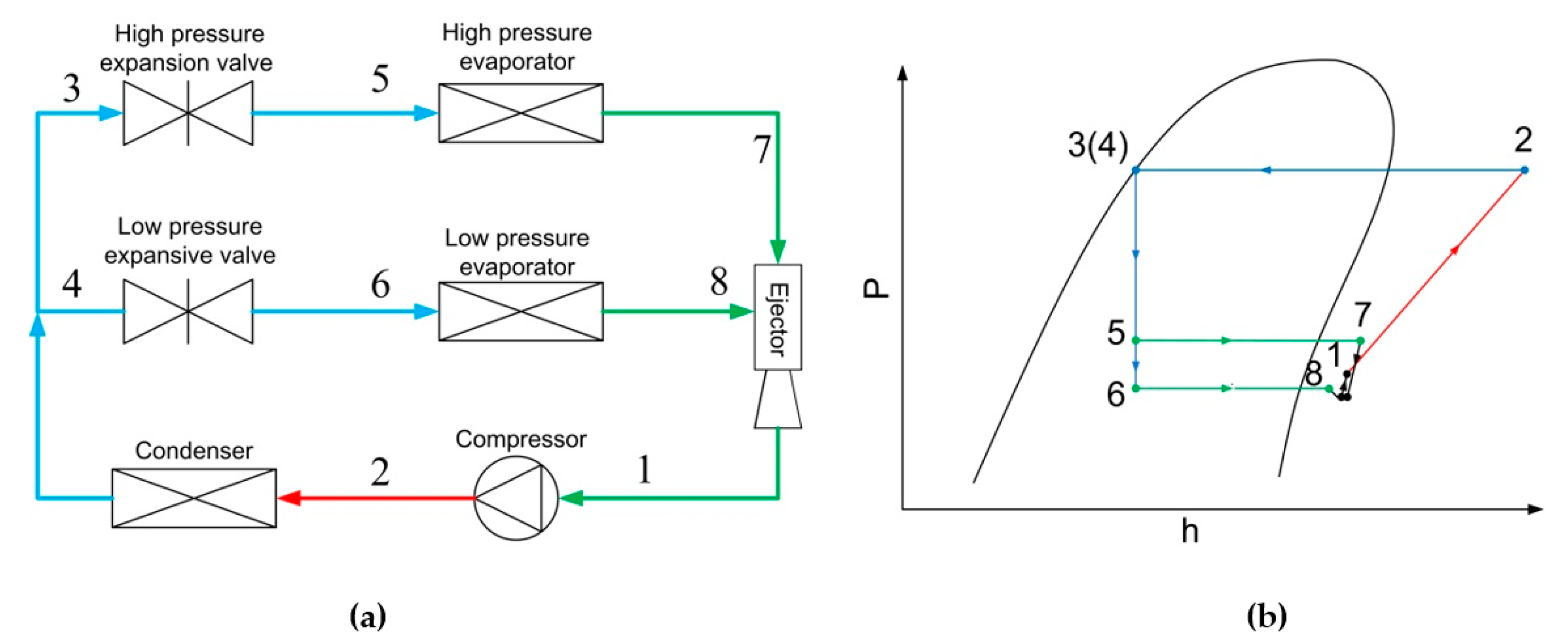
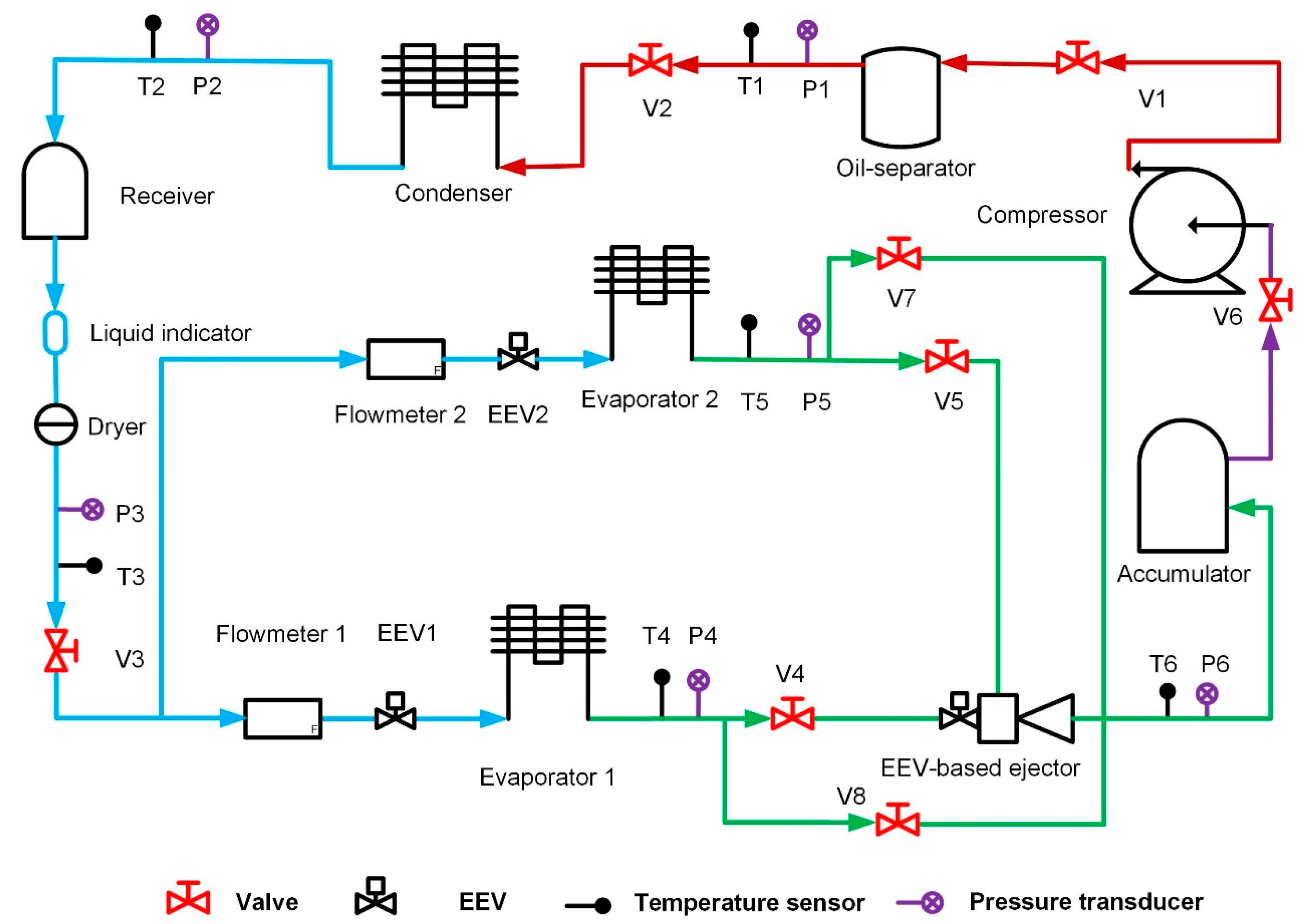

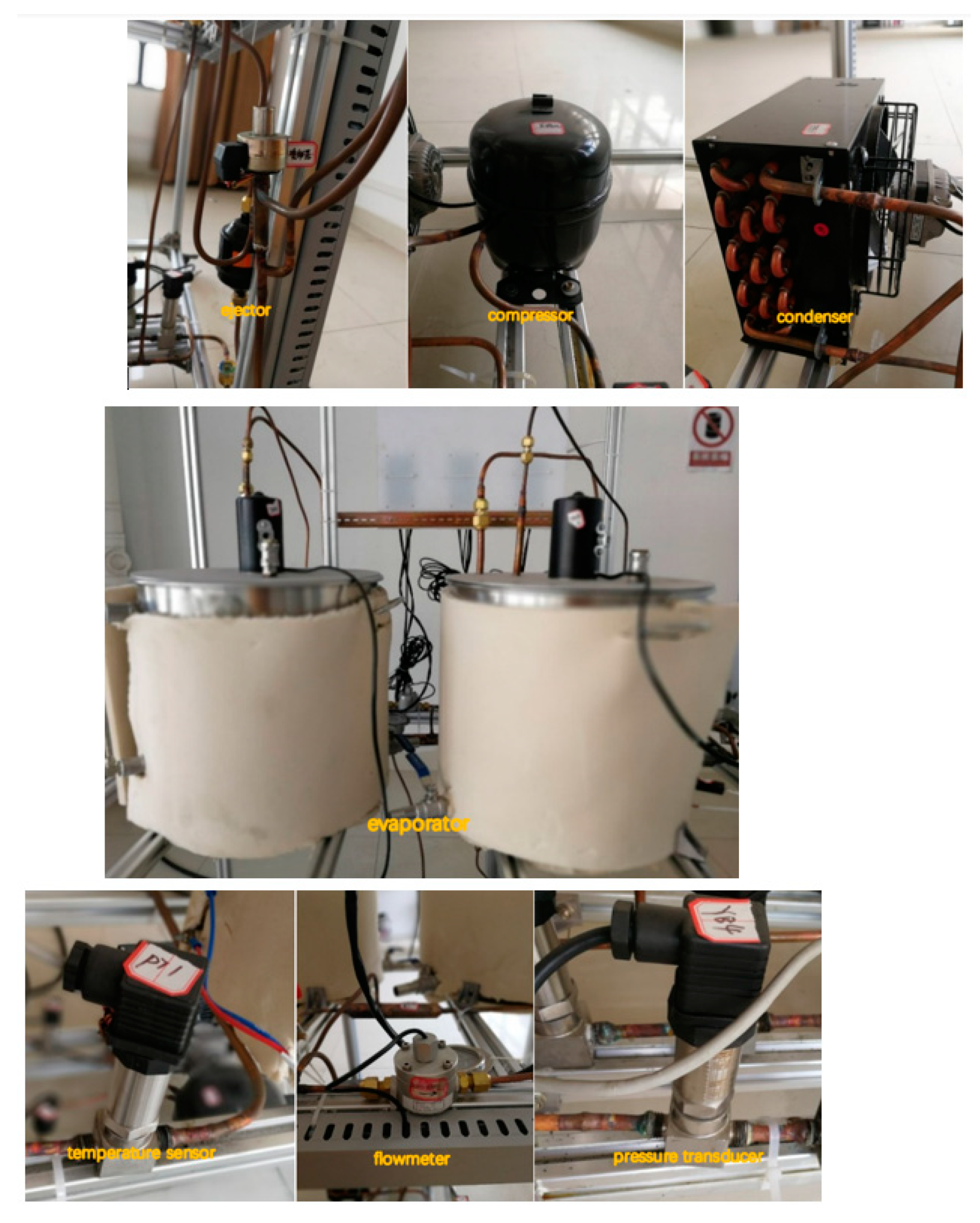
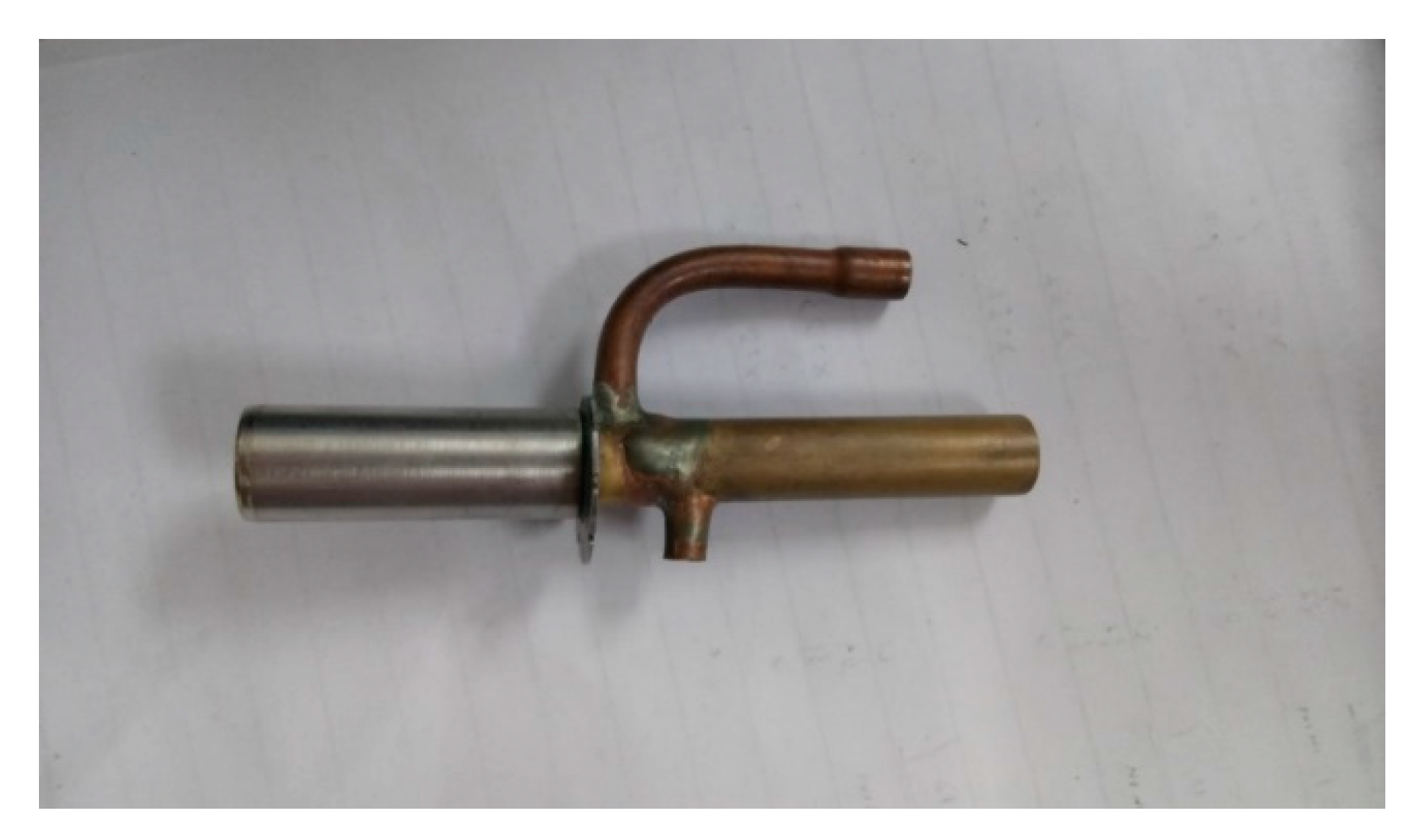


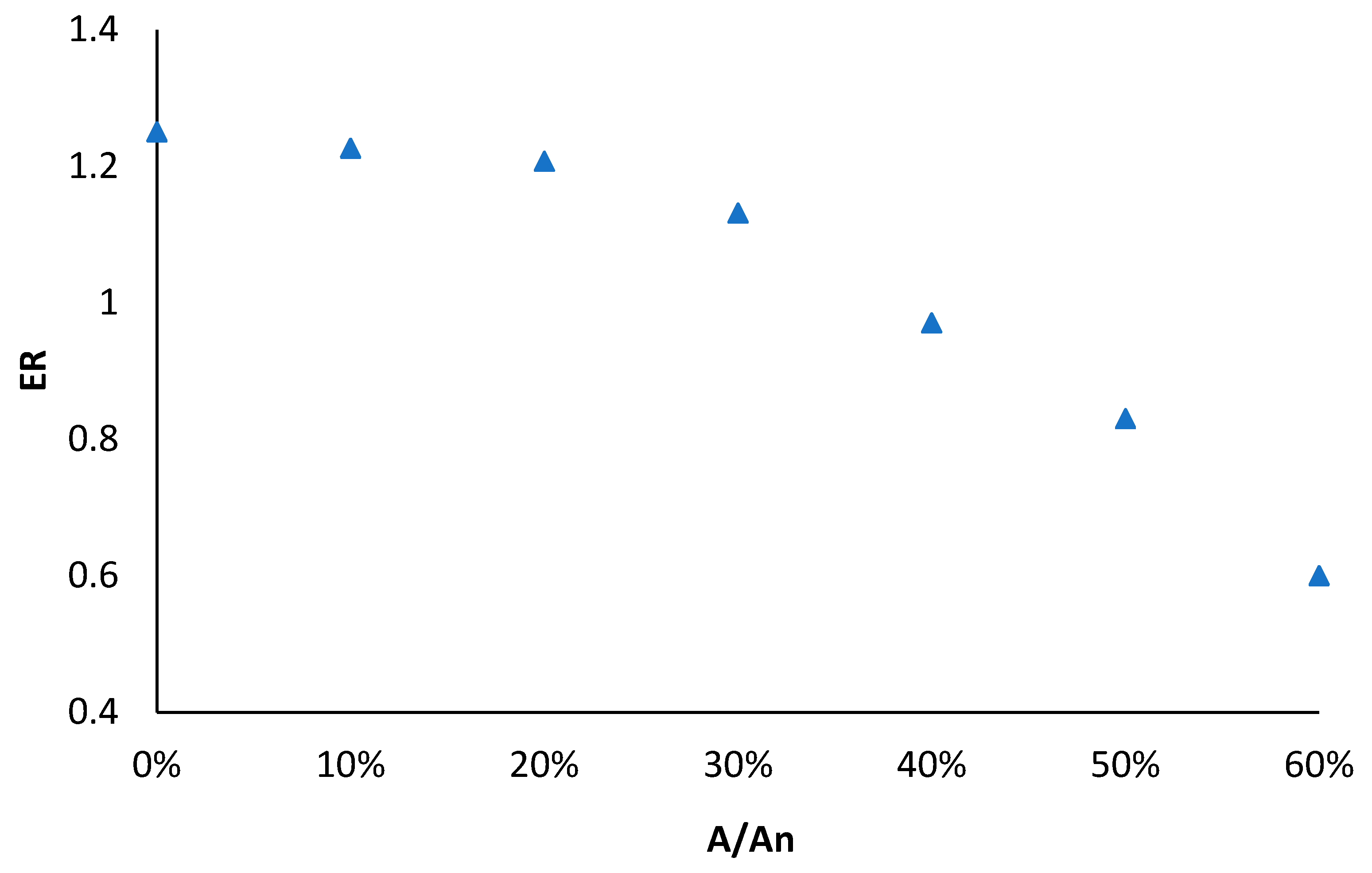


Publisher’s Note: MDPI stays neutral with regard to jurisdictional claims in published maps and institutional affiliations. |
© 2022 by the authors. Licensee MDPI, Basel, Switzerland. This article is an open access article distributed under the terms and conditions of the Creative Commons Attribution (CC BY) license (https://creativecommons.org/licenses/by/4.0/).
Share and Cite
Yan, J.; Wang, C. Experimental Study on a Multi-Evaporator Refrigeration System Equipped with EEV-Based Ejector. Entropy 2022, 24, 1302. https://doi.org/10.3390/e24091302
Yan J, Wang C. Experimental Study on a Multi-Evaporator Refrigeration System Equipped with EEV-Based Ejector. Entropy. 2022; 24(9):1302. https://doi.org/10.3390/e24091302
Chicago/Turabian StyleYan, Jia, and Chen Wang. 2022. "Experimental Study on a Multi-Evaporator Refrigeration System Equipped with EEV-Based Ejector" Entropy 24, no. 9: 1302. https://doi.org/10.3390/e24091302
APA StyleYan, J., & Wang, C. (2022). Experimental Study on a Multi-Evaporator Refrigeration System Equipped with EEV-Based Ejector. Entropy, 24(9), 1302. https://doi.org/10.3390/e24091302





